
Crayfish are freshwater crustaceans belonging to the infraorder Astacidea, which also contains lobsters. Taxonomically, they are members of the superfamilies Astacoidea and Parastacoidea. They breathe through feather-like gills. Some species are found in brooks and streams, where fresh water is running, while others thrive in swamps, ditches, and paddy fields. Most crayfish cannot tolerate polluted water, although some species, such as Procambarus clarkii, are hardier. Crayfish feed on animals and plants, either living or decomposing, and detritus.

Reptantia is a clade of decapod crustaceans named in 1880 which includes lobsters, crabs and many other well-known crustaceans.
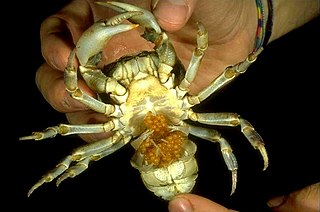
Pleocyemata is a suborder of decapod crustaceans, erected by Martin Burkenroad in 1963. Burkenroad's classification replaced the earlier sub-orders of Natantia and Reptantia with the monophyletic groups Dendrobranchiata (prawns) and Pleocyemata. Pleocyemata contains all the members of the Reptantia, as well as the Stenopodidea, and Caridea, which contains the true shrimp.

The Achelata is an infra-order of the decapod crustaceans, holding the spiny lobsters, slipper lobsters and their fossil relatives.

The Stenopodidea or boxer shrimps are a small group of decapod crustaceans. Often confused with Caridea shrimp or Dendrobranchiata prawns, they are neither, belonging to their own group.

Astacoidea is superfamily of freshwater crayfish that live in the Northern Hemisphere. The other superfamily of crayfish, Parastacoidea, lives in the Southern Hemisphere. Astacoidea consists of three families: Astacidae, Cambaridae, and Cambaroididae. Crayfish are closely related to lobsters, as shown in the simplified cladogram below:

Astacidea is an infraorder of decapod crustaceans including lobsters, crayfish, and their close relatives.

Raninoida is a taxonomic section of the crabs, containing a single superfamily, Raninoidea. This group of crabs is unlike most, with the abdomen not being folded under the thorax. It comprises 46 extant species, and nearly 200 species known only from fossils.
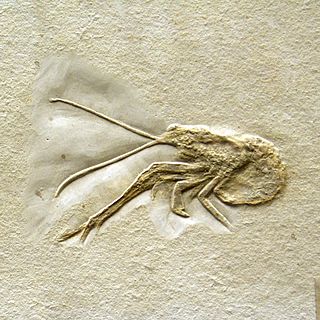
Glypheidea is an infraorder of lobster-like decapod crustaceans, comprising a number of fossil forms and the two extant (living) genera Neoglyphea and Laurentaeglyphea: The infraorder was thought to be extinct until a living species, Neoglyphea inopinata, was discovered in 1975. They are now considered "living fossils", with over 256 fossil species discovered, and just two extant species.

Astacidae is a family of freshwater crayfish native to Europe, western Asia and western North America. The family is made up of four extant (living) genera: The genera Astacus, Pontastacus, and Austropotamobius are all found throughout Europe and parts of western Asia, while Pacifastacus is native to western United States and British Columbia, but has also been introduced elsewhere.
Cyclodorippoida is a group of crabs, ranked as a section. It contains the single superfamily Cyclodorippoidea, which holds three families, Cyclodorippidae, Cymonomidae and Phyllotymolinidae.
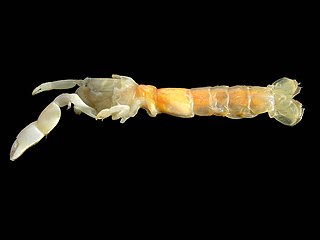
Callianassidae is a family of ghost shrimp crustaceans belonging to the infraorder Axiidea, within the order Decapoda.

Astacoides is a genus of freshwater crayfish endemic to Madagascar. The first specimens were brought to Europe in 1839, and seven species are now recognised, most of which are considered as threatened on the IUCN Red List. They are large and slow-growing, and are threatened by habitat loss, overexploitation by local people and by spread of introduced non-indigenous marbled crayfish. They are only found in a relatively small part of the island, mostly in undisturbed upland areas. They belong to the Gondwana-distributed family Parastacidae, but their nearest relatives live in Australasia, there being no native crayfish in mainland Africa or India.

Dromioidea is a superfamily of crabs mostly found in Madagascar. Dromioidea belongs the group Dromiacea, taxonomically ranked as a section, which is the most basal grouping of Brachyura crabs. Dromiacea likely diverged from the rest of Brachyura around the Late Triassic or Early Jurassic, and the earliest fossils attributable to the Dromioidea date from the Late Jurassic.

Dromiacea is a group of crabs, ranked as a section. It contains 240 extant and nearly 300 extinct species. Dromiacea is the most basal grouping of Brachyura crabs, diverging the earliest in the evolutionary history, around the Late Triassic or Early Jurassic. Below is a cladogram showing Dromiacea's placement within Brachyura:

Polychelida is an infraorder of decapod crustaceans. Fossil representatives are known dating from as far back as the Upper Triassic. A total of 38 extant species, all in the family Polychelidae, and 55 fossil species have been described.
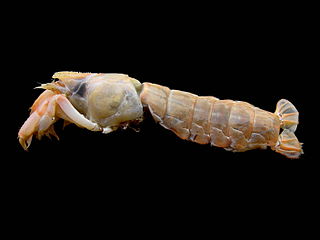
Gebiidea is an infraorder of decapod crustaceans. Gebiidea and Axiidea are divergent infraoders of the former infraorder Thalassinidea. These infraorders have converged ecologically and morphologically as burrowing forms. Based on molecular evidence as of 2009, it is now widely believed that these two infraorders represent two distinct lineages separate from one another. Since this is a recent change, much of the literature and research surrounding these infraorders still refers to the Axiidea and Gebiidea in combination as "thalassinidean" for the sake of clarity and reference. This division based on molecular evidence is consistent with the groupings proposed by Robert Gurney in 1938 based on larval developmental stages.
Procarididea is an infraorder of decapods, comprising only eleven species. Six of these are in the genera Procaris and Vetericaris, which together make up the family Procarididae. The remaining five species are only known from fossils and belong to the genus Udora, which cannot yet be assigned to any family.
Aenigmastacus crandalli is a species of fossil freshwater crayfish. It was found in early Eocene Okanagan Highlands lake deposits in British Columbia, and was described in 2011. It is the first member of the Gondwana-distributed family Parastacidae to be found in the Northern Hemisphere, and is the only species in the genus Aenigmastacus. Twelve specimens are known, with a total body length of 3–5 cm (1.2–2.0 in). On some specimens, details of the internal anatomy can be seen due to the exceptional preservation.
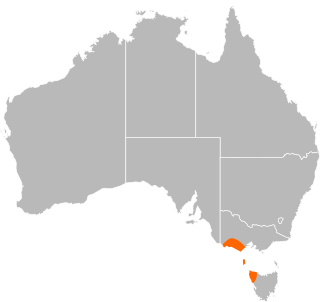
Geocharax is a genus of southern crayfish in the family Parastacidae. There are two described species in Geocharax, both found in Australia.


















